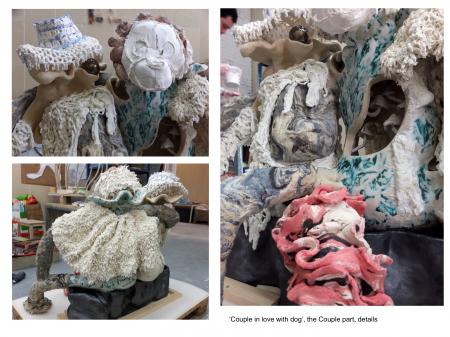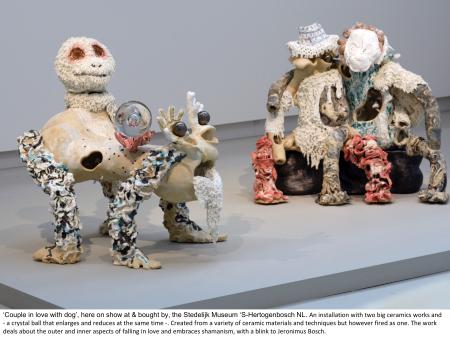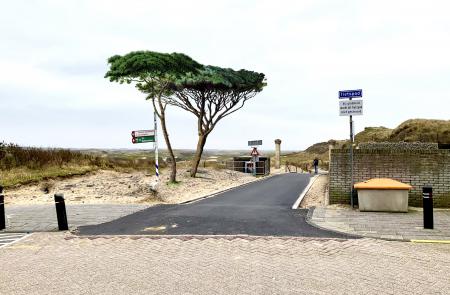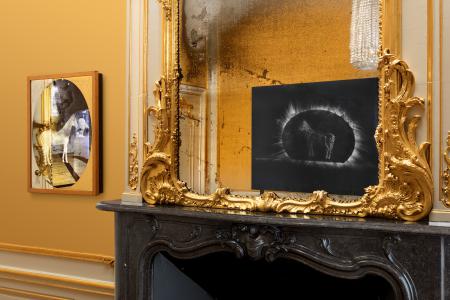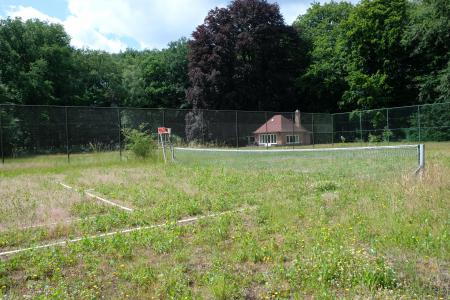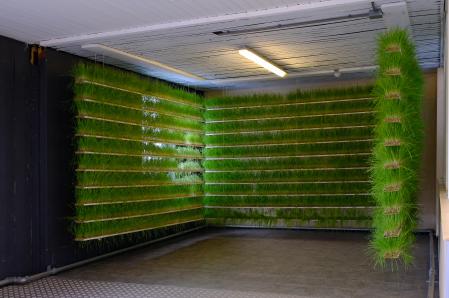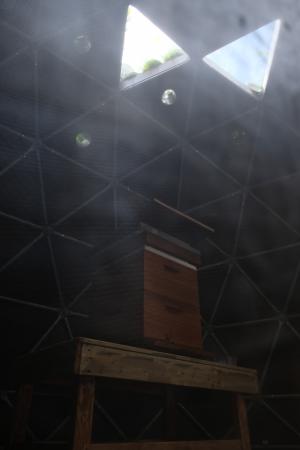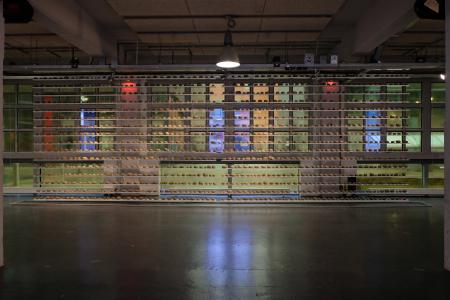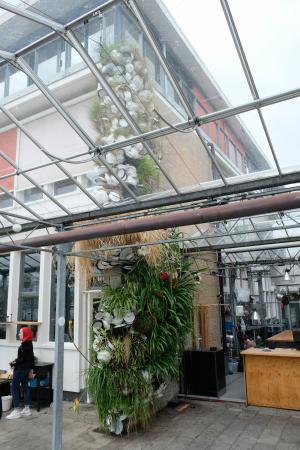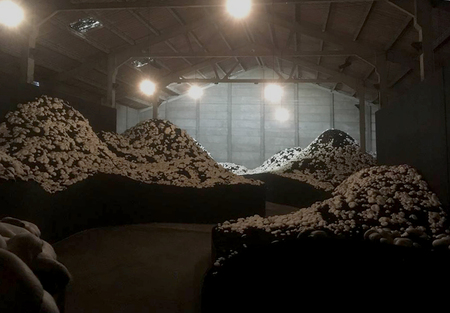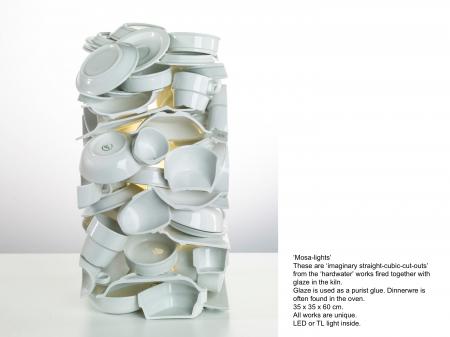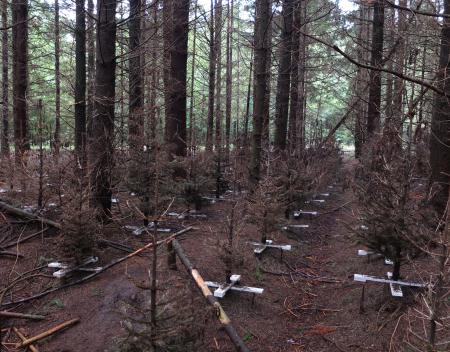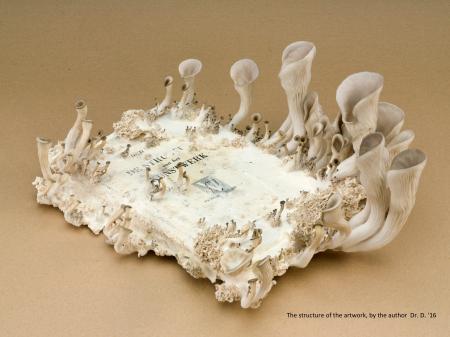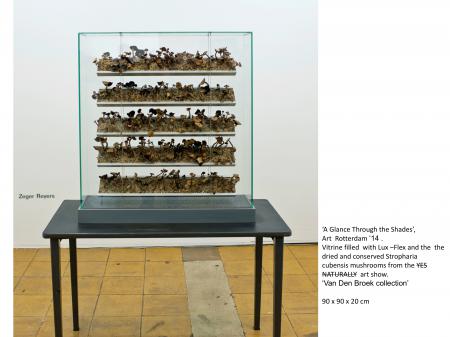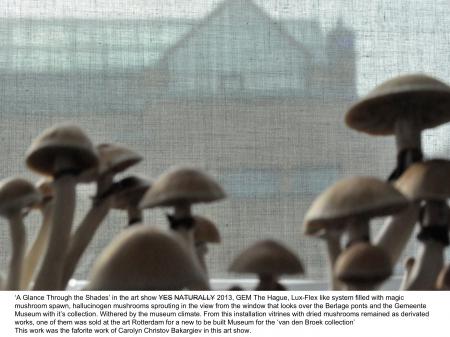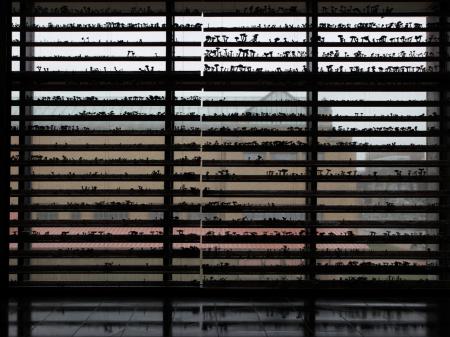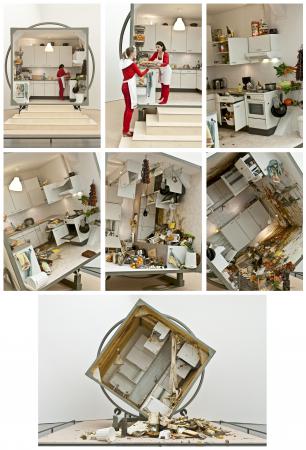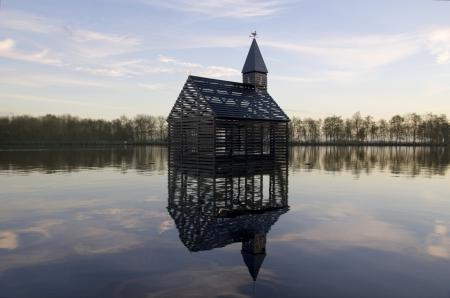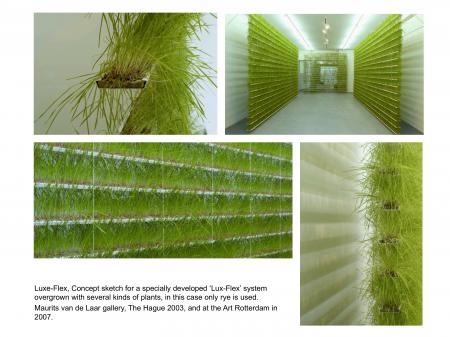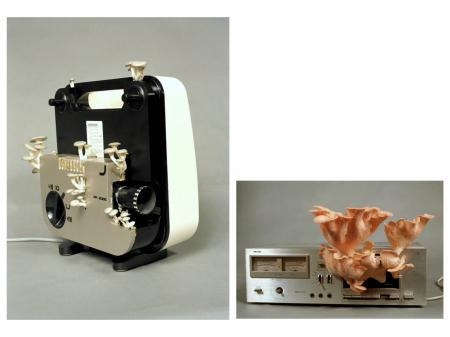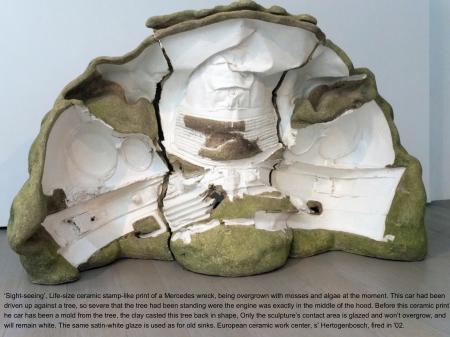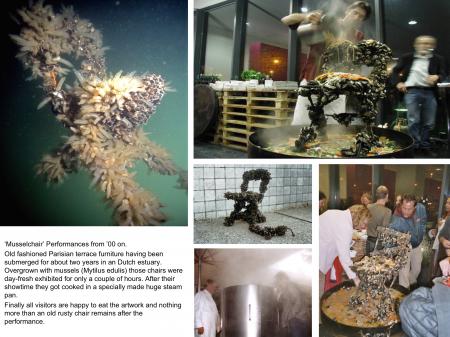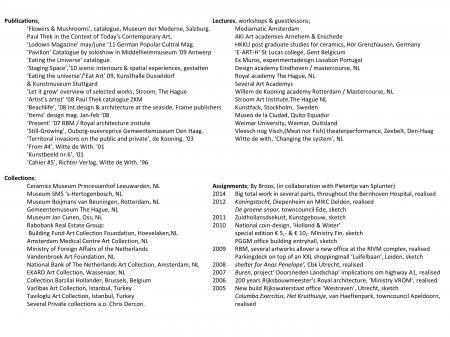-
info
-
info
On show the until the 26th of october '25 at the museum princessenhof in Leeuwarden
-
info
'Couple in love with dog’, here on show at & bought by, the Stedelijk Museum ‘S-Hertogenbosch NL. An installation with two big ceramics works and - a crystal ball that enlarges and reduces at the same time -. Created from a variety of ceramic materials and techniques but however fired as one. The work deals about the outer and inner aspects of falling in love and embraces shamanism, with a blink to Jeronimus Bosch.
-
info
Paludarium like landscape. Underwater ther's an 2M wide tractor-trail visible in the mud. Visitors were asked to model their own tractor fom different kinds of clay
-
info
For the anual artshouw at Lange Voorhout The Hague. good for 200.000 visitors Artwork at the entrance of the exhibition in the form of a signage board. The monumental size that can be found above the highway. With two large blue plates with a white border and arrows refering to; - Two lanes straight ahead to; 'The Hague/Culture' - And the exit to the top right; ‘From here on everything is allowed’
-
info
‘The gate of Zandvoort’ ’22. Sketch assignment, not executed. Two gate- or boundary posts, a sand hill and two sea pines. It’s is a small piece of no man's land, here between the buildings and natural landscape, a little piece between nature and culture. This spot has the function of a marking point in itself. Such a transition is usually indicated by a nameplate from a town or road. In addition, it is a high place from where you look out over the dune filled landscape. To make it specially noticeable, we have created a work that functions as a gate, a frame and a border, you step through the gate or across the border, from one very distinct landscape into another. This gate also functions as a vista, like a frame around a painting, the landscape is briefly framed and 'fixed' on your retina like a photo. Here the cyclist or walker takes a break for a sandwich or a drink from the water bottle. It is a natural end point on the edge of the village to sit down, enjoy the view and musing. A work of art here must accentuate the specialness of this place, where over-view and inner-view can meet. It must be a work of art that is not immediately noticeable and must be integrated into the environment as much as possible.
-
info
"Whispering horse, or, does time heal all wounds?" Artshow ‘Royal Encounters, for Queen Mother / Regent Emma’ ’22, Voorhout The Hague. Materials used; An old original spotted mirror in the palace, a light box with print, a self-made mirror, an old wooden frame, and mother-of-pearl pigment as stardust; 'the stuff dreams are made of'. A photo in an old original stained mirror of the palace is the starting point of this work This picture has been edited in Photoshop and printed the light box (display-box). The light box is mounted behind an oval cut-out of a self-made mirror in an old wooden frame. It reflects the view of the room and the old mirror with stains and also shows the adjoining room through the open doors, where Emma is embroidering. After all, that was her hobby, but Willem III did not allow her to keep up her hobby in the presence of others, he would become furious about it. Before she met him she liked to embroider and after his death she immediately picked it up again. The horse in one of her embroidery pieces that I used in this work is a detail from a page in a booklet she embroidered for her daughter Wilhelmina; It's called 'white-horse and son'. And shows an embroidered white horse with a brown foal. (but she had given birth to a daughter) In my work this horse stands next to her like a ghost image and watches the embroidery taken place. An other image of the same horse was blown with mother-of-pearl pigment powder onto a panel in the middle of the room.
-
info
“Lawn Tennis” A dilapidated tennis court on the grounds of the former Royal Palace has been given a new net and new lines for ‘Lawn tennis’. The work simply consists of letting the self-sown plants grow in the gravel. These are mainly little birch trees from the large multi-trunked birch further up. The white lines are regularly mowed by me with a ± 30 cm wide lawnmower. This creates a slot in the young growing crop with a white line in the middle. Due to this clear yet manageable height of the plants with mainly white stems, the white lines in the mown recesses remain clearly visible. Playing with the idea of the simplest conceivable labyrinth.
-
info
Lux Flex in an artshow at Steck for Utrecht Down Under
-
info
A work of art as a stage and learning place for the almost extinct 'Black bee' or so-called primeval bee
-
info
A work of art as a stage and learning place for the almost extinct 'Black bee' or so-called primeval bee
-
info
'new growth' for Duane Hanson a corona work
-
info
Artwork without public for visitors to be seen from outside through the bleu gaps in the yellow windows.
-
info
On top of a parking garage a 4 meters big Snipe is watching over a 200 meter long strip planted with living ornamental grasses waving in the wind. The scene reflects on the ‘polders’ that were here on this spot just 15 years ago, where grasses touched the horizon…. Nowadays replaced by cars & houses…. Ironically we stated this entire area between Utrecht, Amsterdam & the Hague “The green Heart”, which now becomes an heart-infarct. The Snipe was a common wetland-meadow bird once Dutch national pride even depicted on the 100,- guilder banknote, the most beautiful series of banknotes i have ever seen.
-
info
-
info
Hard-Water grown inside & outside. Mediamatic Amsterdam From '16 to ‘22 My Hard-Water works began as seemingly impossible stacks of precious and fragile porcelain, clean as an expectant lavishly laid table. You could refer to it as "crisp". Within my oeuvre I often let my work evolve, this column has evolved by crawling up against the wall from an abundantly richly filled table (of which a table version once stood at the Mondriaan fond) and eventually even free in space has come to be. "A ruin is much less convincing if you don't know what a castle is" My work is almost always evolving and one thing leads to another, to meet that process there is also a Hard-Water version “Cosmopolitans”, where a large number of white mice walk, so that the title and the meaning are partly shift. But the mice can take full advantage of their protective color. For Mediamatic I also made a vegetated Hard-Water version that manifests itself half inside & half outside, so two biotopes are united in one work, 4 meters high in the Mediamatic greenhouse and 4 meters above the roof of the greenhouse so that it can the glass is still clearly visible, 4 meters on the corner in the harsh wind, and full sun and 4 meters warm and sheltered behind glass like a head of butterhead lettuce. With the vegetated version an attempt has been made to combine Hard Water with my 'growth, bloom and decay' works such as those with mushrooms, mussels and rye. This is certainly interesting, but the nature of the work is completely different. It overgrows indoors so quickly that the balance between plants and porcelain, and between clean and dirty, is difficult to control. Perfect for Mediamatic but otherwise a difficult job... That's why it lends itself well as a 'mirror image' of the clear outdoor version above the roof, on the other side of the glass.
-
info
-
info
‘On non either side of the wall/the landscape’, Watou Kunstenfestival, Belgium ’19 In a 50-metre-long and 30-metre-wide concrete shed located in the open landscape of West Flanders, a sea of 20-40 cm large white mushrooms grows from a hilly black landscape during the summer of the festival. The soft slopes of the landscape outside are magnified in amplitude in this interior landscape, the slopes are steeper and black, referring to the tragedy of the battlefields. Still hopeful though, because something always grows again, even if it is of a completely different nature and white is the color of innocence.
-
Radioinfo
Radio, Jean Tinguely 1962 / Told by, Zeger Reyers 2018 One of the best artworks ever heard of.
-
info
Title; 'O' Tristana - 2018 Sub Title; 'Ostrea Tristana alium' // alium = different For Catherine Deneuve, in her role of 'Tristana' in Luis Buñuel's film of the same name. But there’s only one that can be the most beautiful. Several hundreds of colorful, plaster-casted oyster shells Oysters are always stuck and locked up in a self-made house, as larva they swim around for a while but once they have settled in they never move again! a sad thing, Because they are so beautiful, and above all they are very different, in color, shape and orientation. Having been evolved this way is all the more amazing because they don't have to be 'beautiful' or 'different' at all. Diversity is one of the conditions for 'attractiveness' in the game of mate choice… within the animal kingdom (everyone is equally beautiful & equally ugly) But Oysters do not need sexual competition or competition at all!! They don't see each other, and reproduce just like coral; by releasing (spawning) large amounts of sperm & egg cells at the same time ... Soooo Oops ... loose in the free water. The current can then take the young larvae very far away. The usefulness of attractiveness or beauty is clear in most species and nature primarily serves to obtain healthy, diverse and strong offspring. Although it is sometimes a bit cumbersome, as with flowers and bees, in the end it does result in a very diverse flower world with an almost equally varied number of fertilisers. On top of that, we also enjoy the honey in all floral flavors!! Speaking of take-away, the beauty and taste of an oyster has been appreciated by people for a very long time. In southern France and Denmark, for example, prehistoric mountains, hand-opened oyster shells have been found. In a cave on Pinnacle-Point, South Africa, the hand-opened shells date back to 165,000 years. One of the theories behind this is that the oysters could be dried and then easily transported inland to serve as a source of salt and fish flavor. After all, salt was scarce if one didn't live near the coast. The mother-of-pearl has also been used ornamentally as long as we can imagine. And when this mother-of-pearl fossilizes, it is sometimes converted into the even more valuable semi-precious opal, which is why there are opal fossils of Oysters. And so we are back to beauty.. Free and imprisoned at the same time... As beautiful and locked up as the young Catharine Deneuve in Buñuel's 1970 film 'Tristana', based on a novel by Benito Pérez
-
info
-
info
This tragical work called “Undergrowth” is situated in a very (much too) dense piece of mathematical straight pine-forest, there I’ve put 150 tiny Christmas trees on white crosses resembling the war-cemeteries. Upon installing the freshly cut trees were still green and over the show they blended more and more in the permanent dark-brown infertile forest-floor.
-
info
nothing left to say a sad artwork that had to be made
-
info
Panorama Continuum is an installation that stretches and extends the way we look at the world around us. The airy work is a panorama turned inside out , the sky is pulled inwards, through the ceiling into the museum. And appears again on a 3D parabolic screen hanging down from ceiling. The seagulls flying around here are not pre-created images but are generated by a computer. They are basically animations that come to life in a simulation program in which the flying movements of each individual bird are determined by the laws of physics and a range of ever-changing behavioural characteristics. This Creates an ever-changing visual spectacle. The pattern of the underlying air is inspired by the sky’s in the paintings from the 17th century Dutch masters, and is always changing as well. The only constant here is a 20 minutes day and night cycle. To experience the work in its Entirety, the viewer can best walk around the 3m diameter projection. And look up to the 3.5 meter high tripod frame from which the projection screen hangs down, allowing the ever-changing picture on the entire 360° surface and the sound of the birds to sink in. This work only uses one 4K projector and a special lens kit to project the full dome image. The title of the work Primarily Means a collection of all possibilities or values without interruptions, and also refers to the ‘relativity’ in physics, where the dimensions of time, space and matter together form a continuum. While in this work the sky’s vanishing point is placed in the central middle of the work. Was on show from april t/m september 2016 in the Panorama Mesdag Museum, The Hague. Credits The bird simulation was made in collaboration with artist and game designer Rob Bothof. The construction and parabolic fabric with Tessa Bekker and KWI Delft. Projection technique with by from Full Dome Media. For the development of this artwork Museum Panorama Mesdag, received a grant provided by the Mondriaan Fund. By ‘Broos’, Zeger Reyers & Pietertje van Splunter.
-
info
Living mushrooms are growing on the cellulose from a book with the tilte 'The structure of an artwork', by Dr. D.
-
info
-
info
‘Free Floating Tree’ KAdE Amersfoort ’15. On show in the exhibition 'Expeditie Land Art' by curator; Sandra Smallenburg. This tree is a Ficus benjamina and is the most commonly planted tree in fancy office gardens, all imported mostly from China and all flown in. For this exhibition, this special tree grows horizontally in the middle of the split-level stairwell of the Kunsthal. From the top of the stairs, the roots firmly anchored in 'the ramp' while the branches stretch down over the stairs. In turn, the stairs are leading visitors from the basement to the great central hall will have to face the canapé coming down in the center of the stairwell, free from the walls. This subspecies 'Ficus benjamina sp. horizontalis' has grown horizontally for over a year in a greenhouse of a company that trades in office garden trees. A All the tops of the branches have been pruned through the year and the newly formed leaves have grown horizontally towards the light, giving the impression the tree looks has always grown horizontally. This tree in the stairwell creates an obstruction visitors cannot pass without touching it’s leaves.
-
info
is an installation that stretches and extends the way we look at the world around us. The airy work is a panorama turned inside out , the sky is pulled inwards, through the ceiling into the museum. And appears again on a 3D parabolic screen hanging down from ceiling. The seagulls flying around here are not pre-created images but are generated by a computer. They are basically animations that come to life in a simulation program in which the flying movements of each individual bird are determined by the laws of physics and a range of ever-changing behavioural characteristics. This Creates an ever-changing visual spectacle. The pattern of the underlying air is inspired by the sky’s in the paintings from the 17th century Dutch masters, and is always changing as well. The only constant here is a 20 minutes day and night cycle. To experience the work in its Entirety, the viewer can best walk around the 3m diameter projection. And look up to the 3.5 meter high tripod frame from which the projection screen hangs down, allowing the ever-changing picture on the entire 360° surface and the sound of the birds to sink in. This work only uses one 4K projector and a special lens kit to project the full dome image. The title of the work Primarily Means a collection of all possibilities or values without interruptions, and also refers to the ‘relativity’ in physics, where the dimensions of time, space and matter together form a continuum. While in this work the sky’s vanishing point is placed in the central middle of the work. Was on show from april t/m september 2016 in the Panorama Mesdag Museum, The Hague. Credits The bird simulation was made in collaboration with artist and game designer Rob Bothof. The construction and parabolic fabric with Tessa Bekker and KWI Delft. Projection technique with by from Full Dome Media. For the development of this artwork Museum Panorama Mesdag, received a grant provided by the Mondriaan Fund. By ‘Broos’, Zeger Reyers & Pietertje van Splunter.
-
info
-
info
-
info
"Trage Thorens" Remake ’07 Lee Ranaldo (Sonic Youth) specially made the album “All the stars in the sky” for this project. First version shown was in the Hortus Conclusus exhibition at the, Witte de With art space in Rotterdam ‘01. A showcased Thorens turntable playing a record with each song ending in a circular (endless) groove. Making a 'locked groove' is a speculative process, in which it is initially not clear where the 'weld' will be located and how the 'locked groove' will sound. This apparent arbitrariness is in line with the growth of the pink or yellow mushrooms, which grow from under the turntable during the duration of the exhibition and with their own fruiting bodies very slowly bring the LP to a halt with distorted sounds. The sound coming from the display case is muffled by the glass shade.
-
info
-
info
-
info
-
info
‘A Glance Through The Shades’ in de tentoonstelling ‘Ja Natuurlijk’ in het GEM te Den Haag. Het werk 'A Glance Through The Shades' bestaat uit speciaal ontworpen aluminium lamellen voor een groot venster in het trappenhuis van het GEM, die geheel begroeid zijn met Stropharia cubensis paddenstoelen, beter bekend als 'magic mushrooms'. De verruimende werking van het bewustzijn is één van de pilaren waar de kunst in zijn algemeenheid op gefundeerd is. Bovendien speel ik hier met de Opiumwet, want toen dit werk bedacht werd waren deze paddenstoelen in verse vorm nog niet illegaal en in gedroogde vorm wel. Tijdens alle voorbereidingen zijn zijn beide vormen illegaal geworden voor de NL-wetgeving. Maar kweekpakketten van dezelfde paddenstoelen zijn tot de dag van vandaag nog steeds in de handel. Voor het maken van deze installatie zijn de paddenstoelen twee weken voor de opening in de vorm van kweekpakketten in een ‘plastic-kas’ aangebracht. Vlak voor de opening is het plastic verwijderd en zijn de paddenstoelen hier in de tentoonstelling uit het niets, zo de illegaliteit ingegroeid. En om niet te verslijmen en zich tot blijvend zichtbaar resultaat gedurende de tentoonstelling te manifesteren zijn ze door het museumklimaat ook nog eens uitgedroogd in welke staat ze tot het eind van de tentoonstelling te bezichtigen waren. Maar het werk gaat ook over het uitzicht achter het raam, tussen de paddenstoelen door ziet men het Gemeentemuseum. En ik wil kanttekeningen plaatsen bij het ‘droge-stof-gehalte’ van kunst in musea, o.a. door de mooie collecties die ze beheren. Het zijn vaak goed geconserveerde werken en fantastische geschiedkundige ankers die we echter wel in hun eigen tijd moeten zien te begrijpen. Ze hebben eigenlijk altijd aan actualiteit ingeboet, waardoor de toeschouwer actief zich in de situatie van deze collecties moet inleven. 'A Glance Through the Shades' kan ook gezien worden als de introductie van oncontroleerbare elementen in een traditioneel gecontroleerde en puur menselijke habitat het museum.
-
info
Out of the Frying Pan, Into the Fire “Bad cooks – and the utter lack of reason in the kitchen – have delayed human development longest and impaired it most.” Friedrich Nietzsche “If you can't stand the heat, get out of the kitchen.” Harry S. Truman The kitchen is becoming an increasingly important part of our homes. Architects' ideas of how modern flats should be designed and the increasing number of cooking shows on television in the last years seem to have triggered the transformation of the kitchen from a practical place to a central social space it now is in many modern homes. Originally, the kitchen was like a microcosm in our houses, a practical place where things were being produced, where food was being prepared. The kitchen used to be a working space more than a living space. Nowadays both uses are combined in spacious and loft-like flats with open kitchens. The distance between the cook and his family and guests is minimised by the fluidity with which the living room transforms into kitchen space and dining room. The term ?naked chef', as coined by Jamie Oliver – one of the first TV cooks to have implemented ?fusion cooking' in everyday cooking –, is well in place for these new homes: the cook performs before the eyes of all those present, be it family, friends or people that visit for the first time. It is not by chance that the terms ?cook', ?cooking' and ?kitchen' since long have been used metaphorically. To cook is to create and cooking needs inventiveness as much as it needs discipline. A cook is in the kitchen what a captain is on the bridge of a ship. The above quotes from Nietzsche and Truman of course do not refer to the kitchens we all have in our homes, but to the world outside of this kitchen. The world as a kitchen, where ingredients become food, which is being cooked up, heated, kept in the fridge, reheated, deep-frozen, put in the microwave, thrown away, left to rot... Artist Zeger Reyer must have thought that to visualise the world as a metaphorical kitchen, one must transform the kitchen back into a microcosm, into a world in itself, like he did for his work Rotating Kitchen, commissioned by the Kunsthalle Düsseldorf for the exhibition Eat Art. Zeger Reyer's work is characterised by natural and scientific processes, which he applies to humanise the exhibition space. To name a few examples, he made works in which live mushrooms grow from everyday objects, such as furniture, toys and household machinery. At occasions, Reyers prepared and served the full-grown mushrooms to be eaten at the finissage of the exhibition. Or he sank a Parisian terrace table and chairs into the Westerschelde to lift them months later covered with mussels. He would cook and serve these at the opening of his exhibition, where the audience literally emptied the work of its once living content, leaving only the opened, empty shells attached to the furniture, as if it were a bronze monument. With Rotating Kitchen the artist goes a step further in his use of natural and scientific processes, and in his attempts to humanise the exhibition space by letting the visitor of the museum wonder at the beauty of chaos and decay that the work displays. Imagine a fully equipped kitchen in the middle of an exhibition space, and in which a cook prepares the snacks and serves the drinks for the opening reception of the exhibition. When more than half of the food is prepared and served to the art-loving audience, and when the dishwasher is full and switched on, the cook leaves the kitchen with all the containers with ingredients and pots of herbs and spices open, as well as all half-prepared food out there on the counter with the opened bottles of wine, presumably to take a cigarette break or a toilet stop. When he walks away from the kitchen, it slowly starts to tilt and turn, until it rotates completely around its axis in about fifteen minutes – which it actually will keep on doing for the duration of the exhibition. Everything in the kitchen at first starts to slide and soon to fall on the walls and cupboards when these become the bottom part of the kitchen, and so on. While the kitchen turns it transforms into a big kitchen machine, mixing ingredients, food, spices, herbs, kitchenware, both clean and dirty plates and glasses, wine from the open bottles... Fluids drip from whatever is ceiling to whatever is floor for the next minutes, and paint the inside of the kitchen to slowly leak out of the structure over time to paint the floor around it as well. As such, the kitchen becomes a painting device and a sound device of rattling kitchenware at the same time, while the smells mingle and boost one and another to turn it into a perfume dispenser as well. With its slow rotation and the continuous mixing of ?ingredients', the kitchen becomes a world in itself, a world at which the visitor is left to wonder. The process of change and decay makes visible how we unconsciously waste food, while other people – often just outside of the windows of our comfortable homes – don't have anything to eat and thus consume our rejected but perfectly edible fodder out of garbage cans. But the Rotating Kitchen also offers us the unknown pleasure of a quotidian space – that we all know very well – gone rebellious by turning itself against us, while creating an alternative but equally beautiful plate to please – or tease – our senses. However, the tasting is to experience the ever-changing views and aromas, rather than trying to palate the result like we would with the normal produce of our kitchens. For the Rotating Kitchen, the time that it produced food has long gone. It has become something else, something uncontrollable. You will be relieved when upon arrival home you find your kitchen still in place and unchanged since you left. Roland Groenenboom, 27 August 2009
-
info
Out of the Frying Pan, Into the Fire “Bad cooks – and the utter lack of reason in the kitchen – have delayed human development longest and impaired it most.” Friedrich Nietzsche “If you can't stand the heat, get out of the kitchen.” Harry S. Truman The kitchen is becoming an increasingly important part of our homes. Architects' ideas of how modern flats should be designed and the increasing number of cooking shows on television in the last years seem to have triggered the transformation of the kitchen from a practical place to a central social space it now is in many modern homes. Originally, the kitchen was like a microcosm in our houses, a practical place where things were being produced, where food was being prepared. The kitchen used to be a working space more than a living space. Nowadays both uses are combined in spacious and loft-like flats with open kitchens. The distance between the cook and his family and guests is minimised by the fluidity with which the living room transforms into kitchen space and dining room. The term ?naked chef', as coined by Jamie Oliver – one of the first TV cooks to have implemented ?fusion cooking' in everyday cooking –, is well in place for these new homes: the cook performs before the eyes of all those present, be it family, friends or people that visit for the first time. It is not by chance that the terms ?cook', ?cooking' and ?kitchen' since long have been used metaphorically. To cook is to create and cooking needs inventiveness as much as it needs discipline. A cook is in the kitchen what a captain is on the bridge of a ship. The above quotes from Nietzsche and Truman of course do not refer to the kitchens we all have in our homes, but to the world outside of this kitchen. The world as a kitchen, where ingredients become food, which is being cooked up, heated, kept in the fridge, reheated, deep-frozen, put in the microwave, thrown away, left to rot... Artist Zeger Reyer must have thought that to visualise the world as a metaphorical kitchen, one must transform the kitchen back into a microcosm, into a world in itself, like he did for his work Rotating Kitchen, commissioned by the Kunsthalle Düsseldorf for the exhibition Eat Art. Zeger Reyer's work is characterised by natural and scientific processes, which he applies to humanise the exhibition space. To name a few examples, he made works in which live mushrooms grow from everyday objects, such as furniture, toys and household machinery. At occasions, Reyers p
-
info
-
info
THE MUSEUM HOLDS ITS BREATH — SARA WEYNS CURATOR MIDDELHEIM MUSEUM After months of busy preparations – initially in the form of thoughts, conversations, proposals, and later through the hard work of many hands – things are now quiet in the vicinity of the Braem Pavilion. The space that is usually used for exhibitions in the winter or the presentation of fragile collection items lies in motionless anticipation of the start of the project by Zeger Reyers in late October. The silence appears to be an illusion. Whoever approaches the pavilion, can see that some things are wrong, that the contemplative quietness of the place is gently being disturbed. Daffodils Next to the path to the entrance of the pavilion, there are whole patches of budding daffodils. It is not an accident of nature: we are looking at a completely anachronistic phenomenon. The yellow flowers we associate with the arrival of spring, the return of life to nature, the precursors of more sun and light: here they function as heralds of sorts. They warn visitors: your walk in the park – your experience of the environment – will be steered by an artist. From here on, nothing is self evident. Imported from South Africa, first severely chilled, and planted in August, Zeger Reyers uses 2500 daffodil bulbs in order to create a transition zone between the autumnal park and the exhibition space. The appeal of colour and flowers invites the viewer to step into the installation that he created specifically for the Braem Pavilion. Accepting the invitation is not without consequences. The park is uncontrolled, but predictable. Wind, cold, rain, sun, insects, nettles, falling leaves and moisture are phenomena which we may not control, but we are familiar with them and therefore they don’t really surprise us. And in any case we have ample space to move about. The installation of Zeger Reyers in the pavilion is in these respects exactly the opposite: it is a highly controlled environment, but o ers virtu- ally no space for movement, and will prove to be highly surprising. Pavilion A few weeks before the opening Zeger Reyers started on the total transformation of the interior. The space that otherwise unfolds as an open, bright and clean surface is now dominated by a huge installation of steel, wood, earth and mushrooms. The wavy structure engulfs the view- er immediately upon entering, heavy and dark. The smell and atmosphere hit you in the face. The staircase that otherwise acts as the starting point
-
info
-
info
Shelter for: Anas penelope, 2008 Floating church on a little lake called "the Duck" at the Oortjespad, Kamerik. Large numbers of the Wigeon a smal duck spiecies, Anas penelope, are usualy wintering at this little pont, hence the name. The Wigeon breeds in Scandinavia, and spends its winters in warmer regions like here. At the meadows surrounding this lake these ducks are being hunt because they would be harmful to the grasslands. An other story about this location tells us that there used to be a shelter church right next to the lake, in use until the mid-19th century by Roman Catholics. After the reformation in the 16th century the churches had fallen into the hands of the Protestants. Catholics from all around came here for their creed. Despite no authentic images of this church have been preserved, we found an historical illustration of this little church showing great resemblance to a church we had seen in Budir in Iceland. One of the the birthplaces of the Wigeon. We merged the these two churches into one see through floating monument offering a symbolic refuge for our winter guest "A kind of homecoming".
-
info
Cosmopolitans White mice gain maximum profit from their protective coloring in this ‘natural’ habitat. I know that mice like to dwell in kitchen cupboards. White mice are almost ‘man-made’ species, that is to say, they don’t exist in nature as such. You’ll find them mostly in laboratories around the world, often used for dermatological experiments for the cosmetic industry. Some storytellers’ rapport of even more laboratory mice on this planet than there are Human beings. By giving them this natural habitat these cosmopolitans can be proud of themselves, and they are to my opinion just as entitled tot be called ‘Cosmopolitans’ as the Ladies magazine. From this work a video work has been made
-
info
-
info
100 Oilbarrels, riding the waves on high tides. From this work derivated a video piece.
-
info
“Aqua-Boogie”, GEM The Hague 2004, To reach “Aqua Boogie”, visitors descend a staircase that has a view across a large pond outside, conveying a feeling of being below groundwater level. This cellar has eversince it’s building in ’62, until the renovation in ’98 been troubled by water, groundwater rose through the floor while rainwater flooded in at a ramp. The visitors enter an irregular 220-square-metre cellar space, flooded with pitch-black water and criss-crossed with pine duckboards allowing the visitors to explore the aqueous biotope closely. It smells of water and pine, water that seems bottomless, and together with the dampened sounds it becomes a serene place. Almost meditative. Until the water surface suddenly moves somewhere, and after a while somewhere else. Beneath the surface 40 black leather carp practically invisible, go about unseen business.
-
info
stacked porselain on a 15 meter long table without the use of any glue
-
info
-
info
-
info
-
info
-
info
-
info
Life-size ceramic stamp like print of a Mercedes wreck, being overgrown with mosses and algae et the moment. This car had been driven up against a tree, so that the tree had been standing in the middle of the hood. The sculpture’s contact area won’t overgrow, and remains white. The same white glaze is used for it as for old sinks and toilets. EKWC, (European ceramic work centre), s’Hertogenbosch, '02 growing since.
-
info
Mussel chair, 2000 Kunstvereniging Diepenheim, 2004 Gemeente Museum The Hague, 2010 Stadtmuseum Innsbruck. Zeger Reyers used the well-known French bistro chair for the mussel chair, which he carefully covered with mussel seed. The prepared chairs were then sunk in the Oosterschelde estuary, on an underwater plot made available by a mussel farmer. In diving gear, Zeger Reyers inspected the seats from time to time and took pictures of them. After two years, the mussels are fully grown and the chair can be harvested. During growth, other organisms and animals also attach themselves to the chair, such as the spout-shaped spouts (?) that can be recognized as white tubes in the photo. Once brought to the surface, the ripe chair is steamed in a pan specially designed for this purpose, and then eaten empty by the public. The tried and tested recipe for the preparation consists of 4 packets of butter, soup vegetables and garlic, and a box of white wine. The mussel chair was consumed in 2000 at the Kunstvereniging Diepenheim and in 2004 during the Cultuurnacht at the GEM in The Hague and later in 2010 in the taxispalais Innsbrück.
-
info
Collaboration
Websites
personal website
zeger.org"Broos' = Pietertje & Zeger
brooswerk.netCurriculum vitae
Education
-
2016 - 2016EKWC European Ceramics Works Centre
-
2002 - 2002EKWC European Ceramic Workcenter
-
1990 - 1995sculpture & installations Rotterdam, Academie van Beeldende Kunsten diploma
exhibitions
-
2024kunstenlab Deventer Deventer, Netherlands Solo
-
2022Lawn Tennis, in de artshow Voorlopers Paleis Soestdijk Soestdijk, Netherlands “Lawn Tennis” A dilapidated tennis court on the grounds of the former Royal Palace has been given a new net and new lines for ‘Lawn tennis’. The work simply consists of letting the self-sown plants grow in the gravel. These are mainly little birch trees from the large multi-trunked birch further up. The white lines are regularly mowed by me with a ± 30 cm wide lawnmower. This creates a slot in the young growing crop with a white line in the middle. Due to this clear yet manageable height of the plants with mainly white stems, the white lines in the mown recesses remain clearly visible. Playing with the idea of the simplest conceivable labyrinth. www.paleissoestdijk.nl/agenda/voorlopers/ Group
-
2022Bee-Ambassy Castellum Hoge Woerd Utrecht, Netherlands A work of art as a stage and learning place for the almost extinct 'Black bee' or so-called primeval bee Solo
-
2022‘Golden potatoes’ ASEC Apeldoorn, Netherlands 'Golden Potato', ACEC Apeldoorn '21 & Quartair Artspace The Hague '21. 300 Kg of potatoes should grow large sprouts in the slats hanging in front of the windows at art building ACEC. Due to the yellow light that reaches the potatoes through filters on the windows, it could have become a wildly overgrown scene. In itself, the wealth of wasteful types of outgrowths is very interesting and the work looks very nice just after installation without sprouts. But I would have liked to see the farmer's promise to buy untreated potatoes fulfilled when they come out. Nevertheless, I intend to continue this series of works with potatoes that behave a bit more wildly. Solo
-
2022Lux-Flex Garden center Steck bij art innitiative 'Utrecht Down Under' Utrecht, Netherlands Artshow in a big gardencenter www.utrechtdownunder.nl/ Group
-
2019'Beyond the wall / the landscape' tou, art & poetry festival Watou, Belgium Solo
-
2017Potato eaters ‘Off Art – Open nights’ Athens, Republic of Korea re-enactment of an old work 'Potato eaters' Group
-
2016Stuck in the mud Songchuan artcenter Songchuan, Netherlands Solo
-
2013New Purchases / 'Couple in love with dog' Stedelijk museum 's-Hertogenbosch SMS 's-Hertogenbosch, Austria 'Couple in love with dog’, here on show at & bought by, the Stedelijk Museum ‘S-Hertogenbosch NL. An installation with two big ceramics works and - a crystal ball that enlarges and reduces at the same time -. Created from a variety of ceramic materials and techniques but however fired as one. The work deals about the outer and inner aspects of falling in love and embraces shamanism, with a blink to Jeronimus Bosch. Group
-
2012YES NATURALLY GEM The Hague The Hague, Netherlands ‘A Glance Through the Shades’ made for the art show YES NATURALLY 2013, GEM The Hague, A lamellas shutter system is filled with magic mushroom spawn, and hallucinogen mushrooms sprout obstructive in your view from the window. semi landscape semi cityscape. The view looks out over two ponds and the Museum with it’s collection. In the work the mushrooms dry, withered by the museum climate. From this installation vitrines with dried mushrooms remained as derivated works, one of them was sold to the ‘van den Broek collection’ or LAM. https://www.lamlisse.nl/en/visit-the-lam/ www.gemeentemuseum.nl/en/exhibitions/yes-naturally Group
-
2012Panorama Continuüm Museum Panorama Mesdag Den Haag, Netherlands Panorama Continuüm is an installation that stretches and extends the way we look at the world around us. The airy work is a panorama turned inside out , the sky is pulled inwards, through the ceiling into the museum. And appears again on a 3D parabolic screen hanging down from ceiling. The seagulls flying around here are not pre-created images but are generated by a computer. They are basically animations that come to life in a simulation program in which the flying movements of each individual bird are determined by the laws of physics and a range of ever-changing behavioural characteristics. This Creates an ever-changing visual spectacle. The pattern of the underlying air is inspired by the sky’s in the paintings from the 17th century Dutch masters, and is always changing as well. The only constant here is a 20 minutes day and night cycle. To experience the work in its Entirety, the viewer can best walk around the 3m diameter projection. And look up to the 3.5 meter high tripod frame from which the projection screen hangs down, allowing the ever-changing picture on the entire 360° surface and the sound of the birds to sink in. This work only uses one 4K projector and a special lens kit to project the full dome image. The title of the work Primarily Means a collection of all possibilities or values without interruptions, and also refers to the ‘relativity’ in physics, where the dimensions of time, space and matter together form a continuum. While in this work the sky’s vanishing point is placed in the central middle of the work. Was on show from april t/m september 2016 in the Panorama Mesdag Museum, The Hague. Credits The bird simulation was made in collaboration with artist and game designer Rob Bothof. The construction and parabolic fabric with Tessa Bekker and KWI Delft. Projection technique with by from Full Dome Media. For the development of this artwork Museum Panorama Mesdag, received a grant provided by the Mondriaan Fund. By ‘Broos’, Zeger Reyers & Pietertje van Splunter. Solo
-
2011scope Scope Basel 2016, Switzerland Presentation in the booth of Maurits van de Laar Galery Group
-
2011Flowers & Mushrooms Museum der Moderne Salzburg, Austria 'Träge Thorens’ the installation This installation with the work ‘Trage Thorens’ as a leading character shows the work in three different stages of art experience. At first all turntables, stuffed with mushroom mycelia, are to be seen stacked on shelves in a well lit cooling vitrine. Then one by one they are taken out to be placed in a museum vitrine to perform. this performance lasts for one week, the grow mushrooms and work like braks on the turntable, silencing the sound from record. After which they are placed on one of the shelves in the drying-vitrine to get dried out. The album the turntable, ‘All The Stars In The Sky’ was specially made for this for by Lee Ranaldo (Sonic Youth). All songs end in a circular (endless) groove. www.museumdermoderne.at/en/exhibitions-events/detail/flowers-mushrooms/ Group
-
2010Pavilion 2011 Antwerp, Belgium Pavilion Solo
-
2010Fuente Oscura Scope artfair Miami, United States A brown-bleu version of a Hard Water column Solo
-
2009‘Eating the Universe’ Kunsthalle Düsseldorf, Kunstmuseum Stuttgard. Germany, taxispalais Innsbrück Dusseldorf / Stuttgard / Innsbrück, Germany participation in 3 musea with 'Rotating-Kitchen' and 'musselchair' artmap.com/kunsthalleduesseldorf/exhibition/eating-the-universe-food-in-art-2009 Group
-
2008‘Membra Disjecta – for John Cage’ Tonspur, Vienna / DOX Prague Vienna / Prague, Austria ‘Membra Disjecta – for John Cage’, in coop. with Lee Ranaldo johncage.tonspur.at/?page_id=92 Group
-
2008Paul Thek in the Context of Today's Contemporary Art ZKM Karlsruhe, Germany "Trage Thorens" Remake ’07 met het album “All the stars in the sky” voor dit project gemaakt door Lee Ranaldo (Sonic Youth). Eerste versie uit de tentoonstelling Hortus Conclusus, Witte de With ‘01, Rotterdam. Een in een vitrine geplaatste Thorens draaitafel die Elpee afspeelt waarvan elk nummer eindigd in een circulaire (eindeloze) -groef. Het maken van een ‘locked groove’ is een speculatief proces, waarbij het aanvankelijk niet duidelijk is waar de ‘las’ zal komen te liggen en hoe de ‘locked groove’ zal klinken. Deze schijnbare willekeur sluit aan bij de groei van de roze of gele paddestoelen, die gedurende de duur van de tentoonstelling onder het draaiplateau uitgroeien en met hum eigen vruchtlichamen heel langzaam de LP met vervormde klanken tot stilstand brengen. Het geluid dat uit de vitrine komt klinkt door de glazen kap gedempt.
Projects
International exchanges/Residencies
-
2018Fuente Oscura’ – Scope artfair, Miami. Miami, Netherlands Scope a side fair at Miami Art fair
-
2007
-
2003Biënnale van Havana, Cuba Havanna, Cuba Biënnale in Havanna
Commissions
-
2022De poort van Zandvoort Gemeente zandvoort Zandvoort, Netherlands
-
2018Sketch assignment for a pavilion at the Floriade made from mycelium and plane wings. Almere, Netherlands floriade.com/
-
2017'the big polder' Gemeente Zoetermeer Sweetlake city, Netherlands sketch for an artwork in the townhall finished
-
2017sketch for the KVL lot Oisterwijk, Netherlands
-
2016sketchassignment for a monument in memory of Jacoba Mulder Amsterdam, Netherlands sketchassignment for a monument in memory of Jacoba Mulder in the Beatrixpark, Amsterdam
-
2016Who Cares, BKKC about “Healing Environment” Tilburg, Netherlands finished
-
2015Columba Exercitus, Powder pigeon van Haeftenpark Gemeente Apeldoorn Apeldoorn, Netherlands Van Haeftenpark, Apeldoorn, NL,‘06. A miniature abstraction of the adjacent former ammunition-storage, shaped like a pigeon-house. Made for a special kind of dove the ‘Columba exercitus’, a species made up by the artists. The history of this pigeon perfectly blends with the history of other kinds of dove species and is to be read on a small white pole identical to another green pole from the town council explaining the situation about the periodical artworks created for this location. ‘Columba exercitus’ was a species that from the beginning of times accompanied army’s and soldiers. And like other brave doves often got medals for their extraordinary faith, courage and loyalty. The name powder-pigeon derivates from an ancient use with the dead bodies of this dove, stung on a pole they appeared to be extremely suited to tamp the gunpowder in the first ancient cannons. Unfortunately this species got extinct during the second world war. Possession of pigeons was forbidden by the occupant exempt from a couple of caretakers who kept some rare species alive. Faith struck during a bird typhus epidemic at the bird-sanctuary from the family Spruit in Gouda where some of the last couples from this species were hold. A permanent artwork, acquired by the town-council Apeldoorn. By Broos. www.brooswerk.net/index.php?page=project&lang=nl&project=3 finished
-
2014The Bernhoven Rainbow Bernhoven ziekenhuis Uden, Netherlands Artworks in Hospital Bernhoven www.brooswerk.net/index.php?page=project&lang=nl&project=16 finished
-
2014Hard-Water, overgrown Mediamatic Amsterdam, Netherlands A version of the work Hard-Water, overgrown with grass-like-leafed plants. 5 meters high on the inside of the green house and 5 meters high on top, above the roof of the greenhouse, outside. They show tho completely different biotopes. www.mediamatic.net/en/page/240708/hard-water finished
-
2012Koningstocht Diepenheim en MIKC Delden, Netherlands finished
-
2011'Paviljon Zandmotor' Provintie ZH / Kunstgebouw Ter Heyde // Rijswijk ZH, Netherlands Pavilion, The Sand-motor ‘11 Proposal for the art plan the Delfland Coast, where a 10 Km wide peninsula (the sand-motor) has been made specially to erode away spreading it’s sand on the coastal line to reinforce this. central in this work are the experience of the landscape and the experience of time. This landmark also combines some of the characteristics from the ‘Panorama’ by the 19 the century painter Message and the ‘Celestial Vault’ by James Turrell, both works are to be found within 15 Km from this location . The former dunes have been replaced by one dyke-like stretch of sand. Where this work added two sand dunes on top to give back a natural and also monumental entrance to the beach. Within the highest dune (it has raised four meters and forty meters in diameter) is the pavilion. The entrance, in the form of a dune path whose walls are becoming higher, gives access to the conical shaped stairwell to the panorama platform: a round, concrete, space with an opening in the ceiling. This opening is the ‘here and now’ from this disc ceiling a cast- aluminum model of the surrounding landscape is hanging down, The ceiling copies the landscape around it to the horizon. All buildings standing up got their replica hanging upside-down pointing down towards the original. It’s a spacial mirror in time. As time progresses and the scenery changes more and more 'Pavilion Zandmotor’ will get an increasingly more dual function: looking at the landscape now, and look at it in the past.� www.brooswerk.net/index.php?page=project&lang=nl&project=15
-
2009About 'Flexspace' and ‘Ygdrasil’ RIVM Bilthoven, Netherlands The RIVM is the Dutch institute thats occupied with the prevention of infectious diseases and monitoring the consumer safety. For a new building (with a, for the employees new open office infrastructure Broos made a series of artworks referring aal the way back to european pre Christian times …. the Edda, the most important source of Northern European mythology. It is a collection of supernatural stories about the urge for victory over disease, death, hunger and poverty as we also know it in our tangible world. The same themes the RIVM deals with. In these works we implanted elements from these mythological stories in the context of the new built RIVM building. Like Odin’s ravens that flew daily over humanity to report to Odin about their physical & psychological wellbeing. The Yggdrasil, the sacred ash tree, forms the guideline and framework for the these works. Around this tree three different worlds are situated; the underworld in the root system of the Ygdrassil, the human world around the trunk and the world of the Gods in the canopy. The work reveals itself to the viewer in time and space through the moving employees, who occasionally touch, cross or enter the created parallel worlds. It’s separate visual journey through the building. That refers to a journey through time and space, a flexible place with a mythical parallel world within the rational world of the institute. www.brooswerk.net/index.php?page=project&lang=nl&project=8 finished
-
2009Car - Pool - Park Kunst & Bedrijf / A'dam Leiden, Netherlands schetsch for a Parking rooftop www.brooswerk.net/index.php?page=project&lang=nl&project=11
-
2006royal coin disign 'Water' Min.Financiën./De Ned. Munt Utrecht, Netherlands royal coin disign 'Water' www.brooswerk.net/index.php?lang=nl&page=project&project=12&img=2
-
2000200 Eyes ‘ministerie VROM’ 200 stippen The Hague, Netherlands Ministry VROM, The Hague 2006. Assignment on the ocasion of the 200th anniversary of ‘Rijksbouwmeester’ (governmental architecture authority). 200 black eyes are looking out of the walls from the building. In the abstraction of the eye only the pupil remains. While at the same time they resemble peeping holes for the employees to watch over the quality of the national architecture and infrastructure. There’s an irony involved in the fact that this building does not have any functional windows to look out from, all windows from the building are focussed on huge internal spaces. First of all the commissionair wanted the work to be an eye-cather. By Broos www.brooswerk.net/index.php?page=project&lang=nl&project=5 finished
-
--Anas penelope, a hideaway church CBK Utrecht Bouwfonds collectie, Netherlands Shelter for: Anas penelope, 2008 Floating church on a little lake called "the Duck" at the Oortjespad, Kamerik. Large numbers of the Wigeon a smal duck spiecies, Anas penelope, are usualy wintering at this little pont, hence the name. The Wigeon breeds in Scandinavia, and spends its winters in warmer regions like here. At the meadows surrounding this lake these ducks are being hunt because they would be harmful to the grasslands. An other story about this location tells us that there used to be a shelter church right next to the lake, in use until the mid-19th century by Roman Catholics. After the reformation in the 16th century the churches had fallen into the hands of the Protestants. Catholics from all around came here for their creed. Despite no authentic images of this church have been preserved, we found an historical illustration of this little church showing great resemblance to a church we had seen in Budir in Iceland. One of the the birthplaces of the Wigeon. We merged the these two churches into one see through floating monument offering a symbolic refuge for our winter guest "A kind of homecoming". www.brooswerk.net/index.php?page=project&lang=nl&project=7 finished
-
--Widyness // sky-goat Gemeente Utrecht Leidscherijn Utrecht, Netherlands On top of a parking garage next to Leidscherijn station, a 4-metre-high Snipe looks over a strip of tall living ornamental grasses that blow gracefully in the wind on top of the parapet. Where the largest new housing estate in Europe has now risen, this scene reflects the polder of yesteryear…. or actually just 10 years ago…. In this work, the grasses visually touch the horizon again, which is a reference to the lost polders of 'Het Groene Hart'. The Snip is an endangered meadow bird that was once popularly called 'Hemelgoat', which was allowed to figure on the most beautiful money in history just before the turn of the century; the FL 100 note. Pietertje van Splunter and Zeger Reyers together made 'BROOS', a green living work of art entitled 'Weidsheid', which refers to the origin of the location, for the parking garage and P+R Berlijnplein. The work of art consists of a Snipe over three meters high and a collection of grasses supplemented by a wide variety of indigenous flowering plants that stand on the edge of the roof. The Snip and plants, together with the iconic tower, form the crowning glory of the parking garage and P+R Berlijnplein. Standing on the roof, you can read the words 'wideness' and 'heavenly goat' on the concrete edges as a reference to the space of the polder landscape of yesteryear with its inhabitants, the snipe. www.kunstinopenbareruimte-utrecht.nl/actueel/kunst-op-dak-parkeergarage-berlijnplein finished
Sales/Works in collections
-
2010'O' Tristana LAM Lisse Lisse, Nederland O Tristana, Mediamatic ’18 Voor Catherine Deneuve & Luis Buñuel. Honderden kleurrijke in gips afgegoten binnenvormen van oesterschelpen liggen op aan de transparante displays die op de ruiten van de kas zijn geplakt. Het licht van de kas en de golven buiten geven deze bijna ‘te-mooie’ vormen een ijlheid en tastbaarheid tegelijk. Het zijn hebbe-dingetjes bedoelt om gejat te mogen worden, wat vreemd genoeg maar heel weinig gebeurt (dat heb ik in eerdere tentoonstellingen met een snip in de vorm van een verkreukeld bankbiljet anders mogen ervaren) Oesters, Het nut van aantrekkelijkheid of schoonheid is bij de meeste individuen wel duidelijk en dient, in de natuur, in eerste instantie om aan nageslacht te geraken. Soms wat omslachtig, via een derde partij, zoals bij de bloemen en bijen. Maar bij oesters heeft deze ‘schoonheid’ totaal geen nut, daarentegen bezitten ze wellicht één van de mooiste lichaamsvormen die we in de natuur tegenkomen, getuige de afgietsels. Triest is ook dat hun gehele leven vast zitten op een rots, altijd opgesloten in hun schelp, ze kunnen elkaar niet eens aanraken. In de gelijknamige film wordt Tristana, gespeeld door Catherine Deneuve, ze leeft in een 'opgesloten vrijheid' bij haar z.g. oh zo vrij denkende liberale stiefoom Don Lope Garrido .. Om haar gedachten en haar hart te bevrijden maakt ze er een spel van om bij alle multipels de mooiste te kiezen; zoals ze aan Don Lope Garrido op een plein met zuilen vraagt: "welke zuil vind je de mooiste", een vraag die hij weghoont als irrelevant …. alle kolommen zijn eender.... Eenzelfde vraag stelt zij later aan de huishoudster als ze aan het wandelen/ dwalen zijn; welke straat ze het mooist vindt teneinde die in te slaan... Tristana doorbreekt mentaal haar gevangen zijn en kiest voor een onderzoekende open houding, naar wat haar fantasie binnen de beperkingen te bieden heeft.... In schril contrast ten opzichte van de houding van Don Lope Garrido...die in een theoretische vrijheid leeft en de jonge Tristana toch nooit meer af zou willen staan aan een geliefde van haar leeftijd..
-
2000Hard Water Bouwfonds collectie Hoevelaken / Den Haag, Nederland Hardwater (instalatie)
-
--2010 Fortis collectie Amsterdam, Nederland Drumstel (video)
-
--AMC kunstcollectie Amsterdam, Nederland Brandslang, Laars (foto's)
-
--Museum Boijmans van Beuningen Rotterdam, Nederland Video Rotating kitchen
Publications
-
2016Ygdrasil Book Kaftwerk-Tilburg Begeleidend kunstboekje
-
2009Paviljoen Book Kaftwerk-Tilburg /Bai-Antwerpen Netherlands Catalogus
-
2009Let it Grow Book Stroom Den Haag / Thonik A'dam Netherlands Stroom Premium publicatie
-
2009Van Flexplek & Ygdrasil Book Kaftwerk-Tilburg Roland Groenenboom & Philip Peters Netherlands Begeleidend kunstboekje
-
2007Stil-Groeien / Still-Growing Monograph Renate Boere / Stroom Den Haag www.stroom.nl/nl/publicaties/publicatie.php?p_id=3636502&lang=en Overzicht catalogus / Kunstboek
-
2007Let it Grow Monograph Stroom Den Haag / Thonik A'dam Stroom Premium publicatie
-
2007Paviljoen Kaftwerk-Tilburg /Bai-Antwerpen Catalogus
-
2007
reviews
-
2016Panorama Continuüm Metropolis M juni , Magazine Eline van der Haak DH, Netherlands Panorama Continuüm
-
2016Ga zitten en droom weg, NRC Handelsblad, 27 april Newspaper Sandra Smets DH, Netherlands Panorama Continuüm
-
2016Panorama gaat op moderne toer, AD stad regio, 29 april, Newspaper Nico Hemmelaar DH, Netherlands Panorama Continuüm
-
2016- Bewegende beelden vullen Mesdags panorama aan. Den Haag Centraal 6 mei Newspaper Egbert van Faasen DH, Netherlands Panorama Continuüm
Awards and grants
-
2012Scope Foundation Award Scope Foundation 2002, United States Zeger Reyers (1966) has won the Scope Foundation Award 2012 with his work Hard Water. At Scope Miami 2012
-
2007Ouborg-prijs Cultuurprijs Gemeente Den Haag Den Haag, Netherlands Ouevreprijs, Gemeente Den Haag; publicatie & solo tentoonstelling Gemeentemuseum.
-
20042003 Fentener van Vlissingen Fonds Utrecht, Netherlands Bee-Ambassy a shelter for 'black bees' in cooperation with Tim Joye (Gent)
Representation
-
--
Secondary art-related activities
-
2018 - 2017KASK Gent Wokshops & lectures
-
2017 - 20232021
-
2017 - 20042005
-
2016 - 20032004
-
2004 - 20022003
-
2003 - 20022022
-
2002 - 20032003
-
2002 - 20022002

